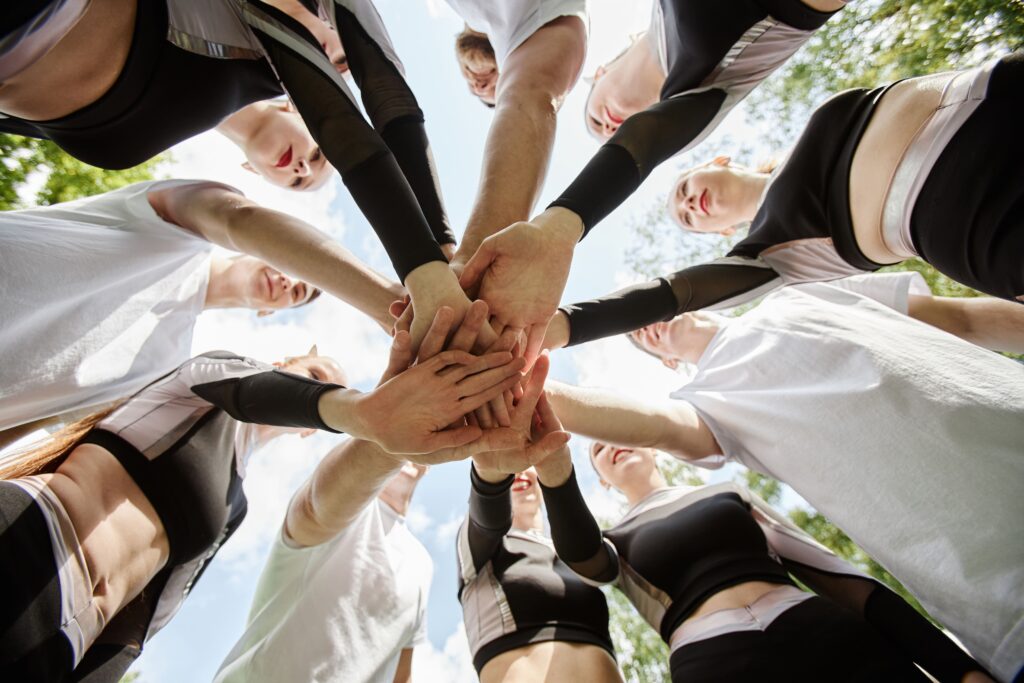Introduction: Why Team-Building Needs a Reboot
If you’ve ever sat through a trust fall or an awkward icebreaker, you know that not all team-building activities are created equal. In 2025, the workplace is hybrid, the workforce is multigenerational, and attention spans are shorter than ever. What employees need today isn’t another “fun Friday.” They need connection — the kind built through shared movement, mutual trust, and real-world wellbeing.
That’s where physical team-building activities come in. Far from being old-school, movement-based activities have made a powerful comeback as HR teams look for ways to improve collaboration, energy, and workplace wellness — while still delivering measurable ROI.
In this blog, we’ll explore:
- Why physical activities outperform traditional team-building
- How they improve health, morale, and engagement
- Ways to connect movement with measurable outcomes
- Ten practical ideas your team can launch this quarter
- And how platforms like Woliba make it easy to track the impact on wellness ROI in 2025
The Shift: From “Fun” to Functional Team-Building
Traditional team-building often focuses on entertainment — escape rooms, trivia nights, happy hours. While enjoyable, these experiences tend to fade quickly and deliver little long-term benefit.
Physical team-building activities, on the other hand, integrate movement, collaboration, and wellbeing. When designed with intention, they help employees strengthen physical health while improving communication, trust, and teamwork — all key drivers of engagement and performance.
According to the CDC, physically active employees have 27% fewer sick days and report higher overall job satisfaction. Meanwhile, Gallup data shows that employees who feel connected to their coworkers are three times more likely to be engaged at work.
That’s not just good for morale — it’s good for your bottom line. When HR teams connect physical team-building to wellness ROI in 2025, they transform movement into a measurable business strategy.
Why Movement Matters for Team Performance
Physical activity affects far more than fitness. It influences the way teams think, feel, and collaborate. Here’s how:
1. It Boosts Cognitive Function
Regular movement increases oxygen flow to the brain, improving memory, creativity, and problem-solving. Teams that move together are often sharper, more focused, and better at innovative thinking — especially in high-stakes environments.
2. It Reduces Stress and Burnout
Exercise releases endorphins and reduces cortisol levels, directly counteracting workplace stress. Group activities amplify this effect by building a shared sense of support and belonging.
3. It Strengthens Connection
When people move together, they communicate differently — more organically, with more empathy and less hierarchy. That’s one reason group fitness challenges or walking meetings can strengthen cross-functional collaboration.
4. It Builds Psychological Safety
Physical activities require vulnerability — trying something new, working through discomfort, or cheering others on. These shared moments help create psychological safety, the foundation for open communication and trust.
5. It Drives Measurable ROI
When physical team-building is tracked through wellness platforms, HR can connect participation data to outcomes like engagement, retention, and absenteeism. That’s the key to proving — and improving — wellness ROI in 2025.
How Physical Team-Building Connects to Wellness ROI in 2025
Most HR leaders already know wellness and engagement are connected — but few have the data to prove it. Here’s how physical team-building creates measurable impact:
1. More Consistent Participation
Movement-based programs naturally invite more participation because they’re experiential. Walking challenges, office yoga, or team step competitions allow employees to contribute on their own terms — whether they’re remote, hybrid, or on-site.
2. Better Retention and Reduced Absenteeism
Organizations that prioritize wellbeing see up to 40% lower turnover, according to Deloitte’s Human Capital Trends report. When employees feel physically energized and emotionally connected, they’re more likely to stay.
3. Enhanced Productivity
Even short bursts of physical activity can improve focus and cognitive performance for up to two hours. When teams embed these moments into their workday, the result is sustained energy — and fewer mid-afternoon slumps.
4. Measurable Health Cost Savings
Companies that integrate movement into their wellness programs have reported up to $3 return for every $1 invested in employee wellness. Over time, these savings compound through reduced healthcare claims and fewer short-term absences.
5. Stronger Employer Brand
A workplace that visibly supports physical and mental wellbeing becomes a magnet for talent. When your employer brand reflects wellness in action — not just words — candidates notice.
In short, wellness ROI in 2025 isn’t just about tracking numbers — it’s about connecting those numbers to culture, energy, and human performance.
10 Physical Team-Building Activities to Launch This Quarter
Each of these activities combines movement, teamwork, and fun — while reinforcing wellbeing across your organization.
1. The Daily Step Challenge
Encourage teams to track steps individually or collectively toward a shared goal — like “Walking to the Moon” or “Across the Country.” Use leaderboards and recognition to keep momentum high.
2. The Outdoor Office Day
Host meetings, brainstorming sessions, or workshops outdoors. Fresh air and sunlight improve mood and creativity — and give your team a much-needed change of scenery.
3. Charity Fitness Events
Sponsor a 5K walk, bike ride, or community clean-up. Connecting physical activity to social impact builds purpose, pride, and camaraderie.
4. Wellness Wednesdays
Designate one midweek activity — yoga, stretching sessions, or group mindfulness walks — to recharge energy and prevent burnout.
5. The Team Obstacle Course
Partner with a local recreation center or park to create a fun, team-based obstacle course. These events promote problem-solving and trust under pressure.
6. Movement Microbreaks
Encourage two-minute stretch or movement breaks every hour. HR can post “movement prompts” in Slack or Teams channels to normalize microactivity throughout the day.
7. Walk-and-Talk Meetings
Replace conference rooms with walking routes. Walking side by side fosters natural conversation and can help employees feel more open during check-ins.
8. In-Office Mini Challenges
Simple daily tasks like “10 squats before lunch” or “30 seconds of desk yoga” gamify physical wellbeing in bite-sized ways.
9. Wellness Retreats or Field Days
Host an off-site event with physical workshops — team hikes, low-intensity sports, or outdoor mindfulness sessions — to reset and reconnect.
10. “Move for a Cause” Month
Tie movement to impact. For every mile walked or minute exercised, donate to a mental health, education, or sustainability cause.
Each of these activities not only boosts morale and wellbeing but also contributes to measurable engagement metrics within your wellness ROI in 2025 framework.
The Data Layer: Measuring the Impact of Physical Team-Building
Launching activities is easy — proving their value is harder. That’s where data comes in.
By layering physical team-building data with engagement and wellness analytics, HR leaders can see:
- Which activities drive the highest participation
- How movement correlates with engagement and recognition
- Whether teams with higher activity rates have lower absenteeism
- How wellness translates into measurable ROI
This kind of insight turns simple activities into strategic initiatives.
For example, if HR notices that teams participating in “Wellness Wednesdays” also show improved focus scores or lower stress ratings in surveys, that’s direct evidence of wellness ROI in 2025.
Making It Scalable: Technology’s Role in Modern Team-Building
Modern wellness platforms make this easier than ever. Through automation and analytics, HR teams can:
- Track participation across departments
- Send reminders, kudos, and leaderboard updates automatically
- Connect physical activity data with engagement and health metrics
- Personalize recommendations for each employee’s fitness level or schedule
The result is a seamless, inclusive wellness experience that feels personal — not prescriptive.
Building a Culture of Movement
The most successful wellness programs in 2025 share one thing in common: they normalize movement.
Physical team-building isn’t a special event or quarterly challenge — it’s woven into everyday culture. When leaders participate, when meetings allow for movement, and when recognition celebrates effort as much as results, employees feel permission to prioritize wellbeing without guilt.
Here’s how HR can reinforce that culture:
- Recognize participation, not just performance.
- Encourage movement during work hours.
- Integrate wellness challenges with recognition platforms.
- Lead by example — leadership participation drives credibility.
When movement becomes part of how your organization works, not just an afterthought, it sustains itself.
The ROI of Human Energy
Ultimately, wellness ROI in 2025 is about human energy — how employees show up, collaborate, and contribute. Physical team-building taps into that energy at its source.
It improves health metrics, strengthens relationships, and creates a ripple effect that enhances every dimension of work: focus, creativity, retention, and culture.
And the best part? It doesn’t require massive budgets or complex systems. It starts with simple, consistent movement — tracked, recognized, and celebrated.
Conclusion: Turning Movement Into Measurable Impact
Physical team-building activities aren’t just about fitness; they’re about connection, energy, and results. When paired with data and intention, they become a core part of your wellness ROI in 2025 strategy.
These activities foster the kind of workplace where engagement feels natural, wellness feels personal, and collaboration thrives.
And with the right tools, HR leaders can go beyond participation numbers to measure what truly matters: how movement transforms teams — and how those teams transform business outcomes.
If you’re ready to turn movement into measurable ROI, visit woliba.io to discover how Woliba helps organizations connect wellness, recognition, and engagement into one powerful platform for growth.








